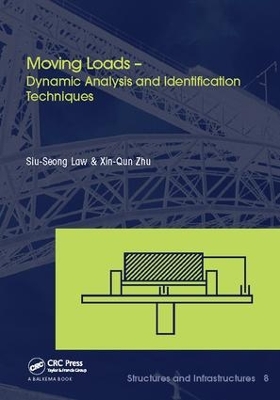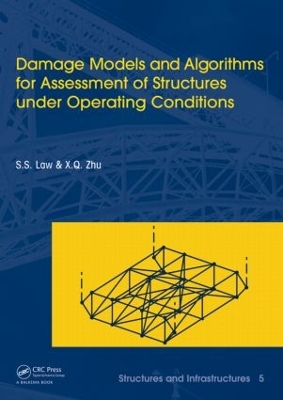Structures and Infrastructures
1 primary work • 3 total works
Vol. 8
Moving Loads - Dynamic Analysis and Identification Techniques
by Siu-Seong Law and Xin-Qun Zhu
The interaction phenomenon is very common between different components of a mechanical system. It is a natural phenomenon and is found with the impact force in aircraft landing; the estimation of degree of ripeness of an apple from impact on a beam; the interaction of the magnetic head of a computer disk leading to miniature development of modern computer; etc. Uncertainty in some of them would lead to inaccurate analysis results on the behavior of the structure. The interaction force is difficult to measure unless instruments have been installed during construction for this purpose. Some of the interaction problems are difficult to quantify due to the lack of thorough knowledge on the interaction behavior. Analytical skills are required to estimate the interaction forces of the mechanical system in order to enable advanced developments in different areas of modern technology.
This volume provides a comprehensive treatment on this topic with the vehicle-bridge system for an illustration of the moving load problem. It covers a whole range of topics, including mathematical concepts of the moving load problems with continuous beams and plates, vehicle-bridge interaction dynamics, weigh-in-motion techniques, moving load identification algorithms in the frequency-time domain, in the time domain and in the state space domain, techniques based on the generalized orthogonal function expansion and on the finite element formulation. The methods and algorithms can be implemented for on-line identification of the interaction forces.
This book is intended for structural engineers and advanced students who wish to explore the benefit of interaction phenomenon and techniques for identification of such interaction forces. It is also recommended for researchers and decision makers working on the operation and maintenance of major infrastructures and engineering facilities.
Damage Models and Algorithms for Assessment of Structures under Operating Conditions
by Siu-Seong Law and Xin-Qun Zhu
Extensive amounts of operational data are generated over time by the health monitoring system of a structure’s management system, yet there are few analysis algorithms which can tell the exact working state of the structure on-line. Good maintenance engineers need to know the exact location and state of the structural components after an earthquake or some attack or accident involving the structure, possibly within a matter of hours, and the client also demands a rapid diagnosis of the structure before making decisions on any necessary remedial work.
This book is devoted to the condition assessment of a structure under operational loading, with most of the illustrations related to a bridge deck under a group of moving vehicular loads. More generally, a wide variety of excitation forces can be exerted on a structure, from earthquake excitation, wind loading, vehicular loading or ambient excitation at the supports. Different algorithms may be used to enable real time identification with deterministic results on the state of the structure. This book also covers a group of damage-detection-oriented-models developed by the author, including a new decomposition of the system matrices of the beam element and plate element. Methods for extending the deterministic condition assessment to provide statistical information are also included. The methods and algorithms described can be implemented for the on-line condition assessment of a structure through model updating of the structure during the course of extreme loading such as an earthquake, or when under normal ambient excitation or operation excitation. Different sample structures are described and analysed, supplemented with major references.
This leading-edge work will be especially useful for researchers and graduate students, and it is also heavily rooted in advanced engineering practice.
Series: Structures and Infrastructures Series
Structures and Infrastructures comprises advanced-level books dealing with the maintenance, management, and cost analysis of structures and infrastructures. Topics treated include research, development and application of the most advanced technologies for analyzing, predicting, and optimizing the performance of structures and infrastructures, such as buildings, bridges, dams, underground construction, offshore platforms, pipelines, naval vessels, ocean structures, and nuclear power plants, as well as airplanes, aerospace, and automotive structures.
Themes featured are mathematical modeling, computer and experimental methods, practical applications in assessment and evaluation, construction and design for durability, decision making, deterioration modeling and aging, failure analysis, field testing, financial planning, inspection and diagnostics, life-cycle analysis and prediction, loads, maintenance strategies, management systems, nondestructive testing, maintenance and management optimization, specifications and codes, structural safety and reliability, system analysis, time-dependent performance, rehabilitation, repair, replacement, reliability and risk management, service life prediction, strengthening and whole life costing.
Assessment of Structures under Operating Conditions
by Siu-Seong Law and Zhu
For over a decade, structural health monitoring for some of the major infrastructures has been implemented. There is a need for suitable algorithms to convert the collected data into knowledge on the evolution of condition of the infrastructure for maintenance scheduling. Assessment of Uncertainties under Operating Conditions addresses recent developments associated with time response series and its derivatives (e.g. the wavelet transform, wavelet packet transform and its energy and the wavelet-based impulse response function). The loads on the structure, such as, the vehicular load, the ground micro tremor and ambient random excitation from the supports, are included in the conditions assessment. In addition, this book deals with the treatment of uncertainties and the study of their propagation in the inverse problem of structural condition assessment.


